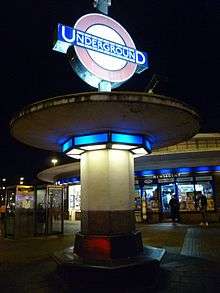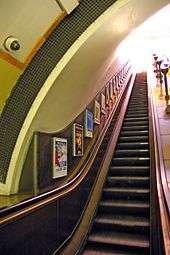Southgate tube station
| Southgate | |
|---|---|
|
| |
 Southgate Location of Southgate in Greater London | |
| Location | Southgate |
| Local authority | London Borough of Enfield |
| Managed by | London Underground |
| Number of platforms | 2 |
| Fare zone | 4 |
| London Underground annual entry and exit | |
| 2012 |
|
| 2013 |
|
| 2014 |
|
| 2015 |
|
| Key dates | |
| 1933 | Opened (Piccadilly Line) |
| Listed status | |
| Listing grade | II* (since 28 July 2009) |
| Entry number | 1188692[2] |
| Added to list | 19 February 1971 |
| Other information | |
| Lists of stations | |
| WGS84 | 51°37′57″N 0°07′41″W / 51.6325°N 0.12805°WCoordinates: 51°37′57″N 0°07′41″W / 51.6325°N 0.12805°W |
|
| |


Southgate is a London Underground Piccadilly line station in Southgate. It is located between Arnos Grove and Oakwood stations and is in Travelcard Zone 4.
History
Southgate station opened on 13 March 1933 with Oakwood on the second phase of the northern extension of the Piccadilly line from Finsbury Park to Cockfosters. Prior to the station's opening, alternative names were suggested including "Chase Side" and "Southgate Central". On opening, local residents were given a free return ticket to Piccadilly Circus.[3]
Architecture
The station is built in the Art Deco/Streamline Moderne design style using brick, reinforced concrete and glass and is one of the best known of the many stations Charles Holden designed for London Underground. The station building is circular with a flat projecting concrete roof. Externally, the flat roof of the raised central section appears, impossibly, to be supported by nothing more than a horizontal band of windows that provide daylight to the ticket hall. The roof is actually supported, umbrella-like, from a central column within the ticket hall. The whole building is topped by an illuminated feature resembling a Tesla coil.

Like Arnos Grove, Oakwood and Cockfosters, Southgate is a listed building in this case at Grade II* (regraded from Grade II in 2009) and retains much of its original decoration. The two escalators have the original column lighting, while bronze panelling is in evidence throughout the station. However; the station is not without change: in the late 1990s, one of the three entrances was filled in to be used as a new ticket office, and due to the design of the automatic barriers, one of the two remaining entrances is exit only.
In 2008 the station was extensively renovated, with new tiling at platform level, a partial new floor in the main ticket hall, and improved signage throughout.[4] The station won the London Regional category award at the 2008 National Railway Heritage Awards for the modernisation of a heritage station.[5]
The original escalators were replaced in the late 1980s with the then standard London Transport design. The balustrade of the escalators was manufactured from bronze, rather than aluminium to maintain the 1930s period appearance of the station and to satisfy the requirements of English Heritage.
The preserved condition of the station's original features, particularly the escalators, makes Southgate popular for filming scenes for period dramas, including scenes for the 1999 version of the film The End of the Affair.
Location
The station was developed as a bus/underground interchange and the main building sits on an island between Southgate Circus and Station Parade where a series of bus stops are located. A secondary building containing shops wraps around the other side of the parade.
The station is located on a hill and whereas the platforms at the stations on each side are on the surface those at Southgate are in a short section of tunnel. The tunnel portals of both ends are visible from the platforms (though not from the same place), a unique occurrence for a deep-level London Underground station. As usual on the Piccadilly line, the platforms are labelled Westbound and Eastbound. However, the tunnels run roughly north-south at Southgate, so eastbound is northbound and westbound is southbound.
In the early 1980s, moving picture advertising was tested in the tunnels south of the station. The pictures were of a child on a beach turning to face the camera.
Southgate is the northernmost station in tunnels on the London Underground network.
Connections
London Buses routes 121, 125, 298, 299, 382, W6, W9, 616, 628, 688 and 699 and night route N91 serve the station.
References
- 1 2 3 4 "Multi-year station entry-and-exit figures" (XLS). London Underground station passenger usage data. Transport for London. April 2016. Retrieved 3 May 2016.
- ↑ "Southgate Underground Station". The National Heritage List for England. English Heritage. Archived from the original on 2012-10-10.
- ↑ Mott, R. (2001). A Southgate Boyhood. Edmonton Hundred Historical Society. p. 22. ISBN 0-902922-61-0.
- ↑ "London Underground". Archived from the original on 2004-12-24.
- ↑ "Previous Winners". Lists of winners. National Railway Heritage Awards. 2008. Archived from the original on 2014-01-26.
External links
| Wikimedia Commons has media related to Southgate tube station. |
- "Photographic Archive". London Transport Museum. Archived from the original on 2008-03-18.
- "Charles Holden". CharlesHolden.com. 1933. Archived from the original on 2003-11-19.
- "Southgate station, external". CharlesHolden.com. 1933. Archived from the original on 2003-12-11.
- "Southgate station, internal". CharlesHolden.com. 1933. Archived from the original on 2004-07-04.
- "Southgate station, at night". CharlesHolden.com. 1933. Archived from the original on 2004-07-03.
| Preceding station | Following station | |||
|---|---|---|---|---|
| Piccadilly line | towards Cockfosters |
